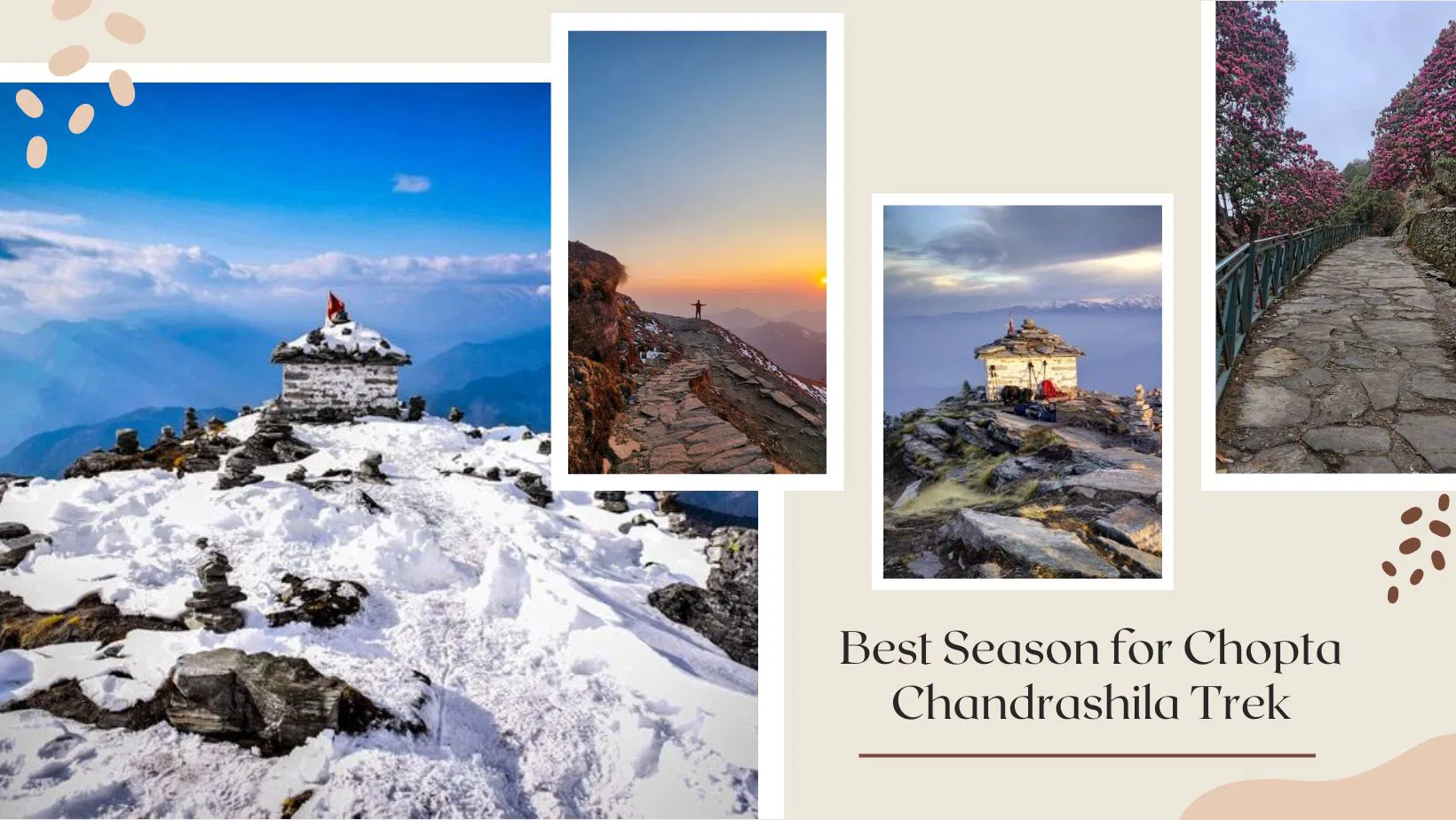Best Time to Visit Chopta for Snow, Trekking & Rhododendrons
Published on July 24, 2025
Chopta Tour Package planning truly depends on what amazing experience you want. This beautiful spot in the Himalayas changes its look all year, offering different charms for everyone. Knowing the best time to visit helps you see Chopta exactly as you imagine it. Whether you dream of walking through deep snow, seeing bright pink and red flowers covering the hills, or enjoying clear mountain views for a perfect trek, Chopta has a season just for you. Each time of year brings its own unique magic, making every visit a special one. This guide will help you pick the perfect moment for your adventure, ensuring your trip matches your dream of Chopta's natural beauty.
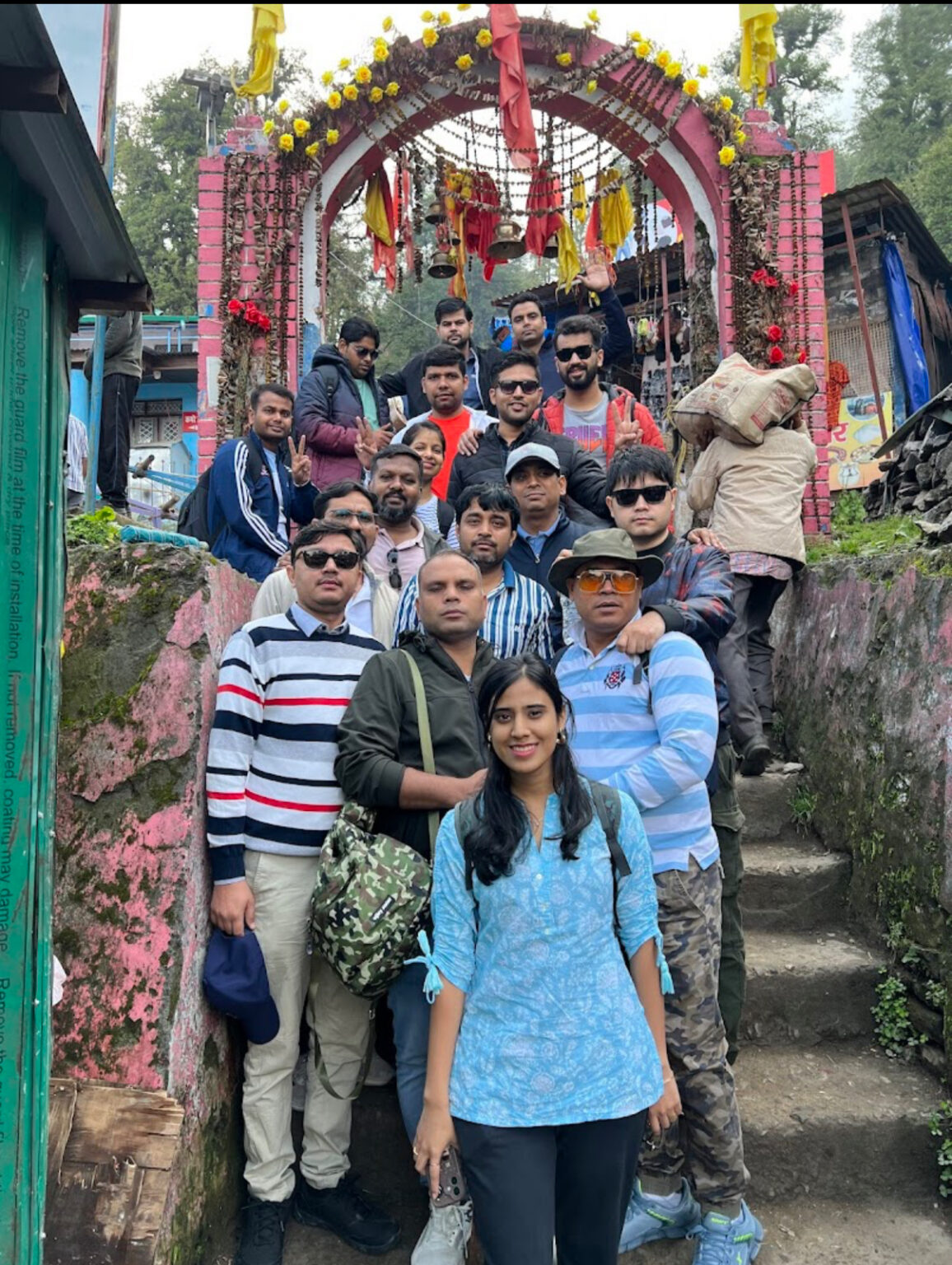
3-Day Itinerary for a Peaceful Yet Adventurous Chopta Getaway
Day 0: Delhi to Rishikesh to Sari Village
- Departure: Start your journey from Botanical Garden Metro Station at 10:00 PM.
- Overnight Journey: Travel overnight towards Sari Village via Rishikesh.
- Stop at Devprayag: Witness the mesmerizing confluence of the Bhagirathi and Alaknanda rivers along the way.
Day 1: Sari Village to Deoriatal
- Arrival at Sari Village: Check into your homestay and take some time to freshen up.
- Trek to Deoriatal: Begin your trek to Deoriatal (2.5 km, approximately 1.5–2 hours).
- Enjoy Deoriatal: Soak in the serene beauty of the lake and the surrounding landscapes.
- Return to Sari Village: Head back to Sari Village and enjoy a peaceful evening.
Day 2: Sari Village to Tungnath & Chandrashila
- Breakfast: Start your day with a hearty breakfast at your homestay.
- Drive to Chopta: A scenic drive of about 1 hour from Sari Village.
- Trek to Tungnath Temple: Embark on a 3.5 km trek to the sacred Tungnath Temple.
- Summit Chandrashila: Extend your trek by 1.5 km to reach the breathtaking Chandrashila summit.
- Return to Chopta/Sari: After the trek, return to Chopta or Sari for an overnight stay at the campsite.
Day 3: Chopta to Delhi
- Breakfast: Enjoy an early breakfast at your campsite in Chopta.
- Departure: Begin your journey back to Delhi in the early morning.
- Visit Dhari Devi Temple: Stop by the revered Dhari Devi Temple en route.
- Arrival in Delhi: A long drive of approximately 10–12 hours marks the end of your adventure.
Inclusion
-
One Night Accommodation In Sari Village.
-
One Night Accommodation In Chopta/Sari Village.
-
4 Meals Will Be Provided Throughtout The Trip.
-
AC Transportation.
-
Guide While trekking.
-
Experienced Trip Captain Throught The Trip.
Exclusion
-
5% GST
-
Extra Drinks, Food, Tea and Snacks.
-
Tickets for any sightseeing or extra activity outside the camp area.
-
Travel Insurance and other benefits.
-
Anything which is not mentioned in inclusions.
-
Cost escalation due to any unforeseen reason like weather, road condition landslide etc.
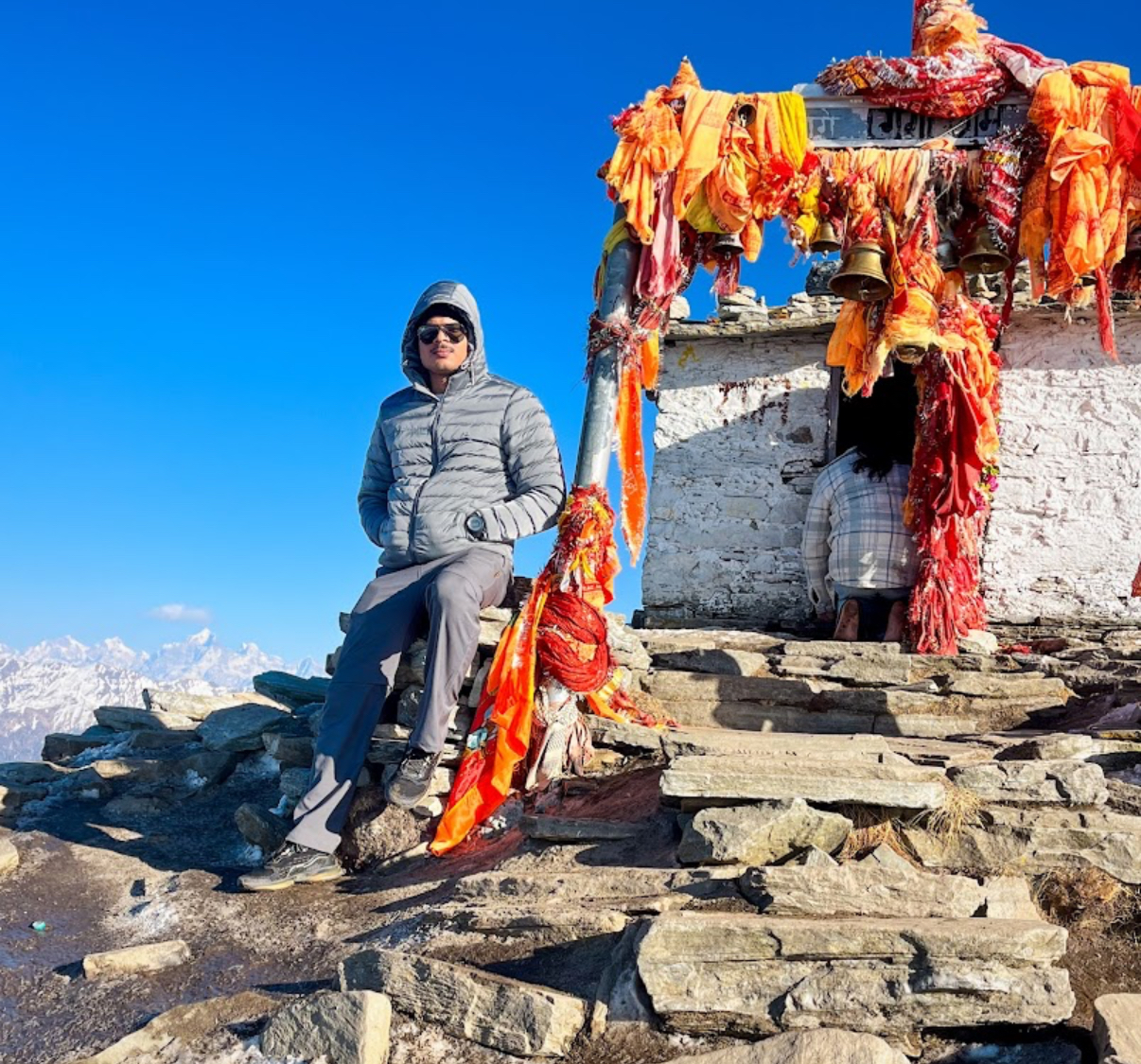
Why Winter Is Magical in Chopta – Snow Trekking & White Forests
Winter in Chopta, from December to March, transforms the region into a truly magical white wonderland. If you're seeking a unique adventure, planning a trip to Chopta during these months offers an unparalleled charm. The entire landscape, including the famous trails for the trek to Tungnath, gets covered in a thick blanket of pristine snow. The air becomes wonderfully crisp and clean, and the deep silence of the snow-laden forests creates a peaceful escape from everyday city life. It's a serene, almost ethereal experience that many travelers cherish.
The biggest pull for visitors during this season is the chance for thrilling snow trekking. Imagine stepping through fresh, soft snow, with tall pine and deodar trees elegantly draped in white. While reaching the Tungnath temple in winter presents a significant challenge due to the snow, the reward of seeing the highest Shiva temple in the world standing majestically against a pure white backdrop is immense. For the truly adventurous, climbing to the Chandrashila summit in winter is an ultimate test of endurance, often requiring special gear like snow boots and gaiters. However, the views from the top, featuring vast panoramas of snow-capped peaks under a clear blue sky, are simply unforgettable.
-
Pristine Snowfall: Witness Chopta entirely covered in deep snow, creating picture-perfect, untouched scenes that are ideal for winter photography.
-
Unique Trekking Experience: Engage in snow trekking, which offers a distinct challenge and a different kind of beauty compared to hiking in other seasons. Routes like the one to Chandrashila become exciting snow expeditions.
-
Deep Serenity: Experience the profound quietness of winter, broken only by your footsteps, providing a deeply meditative and calm environment.
-
Spectacular Views: Enjoy amazingly clear views of prominent Himalayan peaks that stand out sharply against the glistening white snow.
-
Cozy Evenings: After a day out in the chilly snow, returning to a warm bonfire at your camp or guesthouse is the perfect way to relax and reflect on your adventure.
Keep in mind that parts of the journey, especially the Chopta Tungnath trek from Delhi, might face challenging road conditions due to snow. However, for those who love adventure and the raw beauty of winter, a Chopta Chandrashila trek from Delhi in this season promises an unforgettable journey into a frozen paradise. It’s a wonderful time for quiet reflection and capturing dramatic landscapes.

Springtime in Chopta – Rhododendrons, Greenery & Gentle Trails
Spring in Chopta, usually from March to April, is a season bursting with vibrant colors and new life, making it an excellent time to plan a Chopta tour package. As the last bits of winter snow gently melt away, the entire landscape transforms into a brilliant display of lush green, and the forests awaken with the stunning bloom of rhododendrons. These beautiful red and pink flowers, known locally as 'Buransh,' paint the hillsides in vivid hues, creating a wonderful contrast with the fresh green surroundings. It’s a truly picturesque sight.
The walking paths, including those for the popular Chopta Tungnath trek, become more accessible and very pleasant for hiking. The gentle warmth of the sun and the refreshing air make trekking comfortable for people of all fitness levels. This period is perfect for nature lovers and those looking for a less strenuous trek to enjoy the natural beauty without extreme conditions. The path leading to the Tungnath temple is usually clear of snow, allowing for a peaceful visit to the sacred site. Continuing your journey to the Chandrashila summit trek is also very rewarding during spring, often offering clear skies and excellent views without the biting cold of winter or the heavy rains of monsoon season.
-
Rhododendron Bloom: Witness the forests come alive with vibrant red and pink rhododendron flowers, creating a truly spectacular and colorful scene unique to springtime.
-
Lush Greenery: Experience Chopta at its most verdant, with fresh, new foliage emerging everywhere as the natural world gently awakens after the long winter.
-
Pleasant Trekking Conditions: The trails are mostly free of snow and mud, ensuring that your Chopta Chandrashila trek is comfortable and enjoyable for hikers.
-
Mild and Invigorating Weather: Enjoy comfortable daytime temperatures that are perfect for exploring, without the extremes of cold or intense heat.
-
Increased Wildlife Activity: Spring is a great time to spot various bird species returning or becoming more active, adding to the natural charm of your trek.
Taking a Chopta Tungnath trek from Delhi during spring offers an ideal mix of easy walking conditions and stunning natural beauty. It's an excellent season for photography, allowing you to capture the vivid colors of the blooming landscape. Families and beginners looking for a peaceful yet scenic Himalayan experience will find a Chopta tour package in spring incredibly appealing. The Chandrashila trek from Delhi during this time promises not just an adventure but also a delightful visual feast of nature in full bloom.

Is Summer the Best Season for Peaceful Trekking in Chopta?
Summer in Chopta, typically from May to June, offers some of the most ideal weather conditions for trekking and exploring, making it a highly popular choice for a Chopta tour package. During these months, the temperatures are pleasantly cool, providing a refreshing break from the heat that affects the plains. The skies are usually clear, which means you can enjoy magnificent, unobstructed views of the majestic Himalayan peaks stretching far into the distance. This excellent visibility is a major benefit for trekkers aiming for high-altitude spots.
The walking paths for the renowned Chopta Tungnath trek and the exhilarating Chandrashila summit trek are completely clear of snow and generally dry. This makes them perfect for comfortable walking and steady progress. This season is particularly well-suited for those who are new to trekking or for families seeking a peaceful yet adventurous experience in the mountains. The meadows are incredibly lush and vibrant green, creating a picturesque setting, and the air is filled with a refreshing coolness that invigorates you. Visiting the Tungnath temple trek in summer means the temple is fully accessible, allowing pilgrims to offer their prayers with ease and comfort.
-
Clear Skies: Enjoy excellent visibility with crystal-clear skies, which provide breathtaking panoramic views of the entire Himalayan range from high points like the Chandrashila summit trek.
-
Comfortable Temperatures: Daytime temperatures are mild and very pleasant, making them ideal for long hours of trekking without feeling too hot or too cold.
-
Accessible Trails: All major trekking routes, including the full Chopta Chandrashila trek, are open and in prime condition, ensuring much easier navigation.
-
Lush Meadows: The alpine meadows are at their greenest and most vibrant, creating wonderfully picturesque landscapes perfect for relaxation and photography.
-
Full Temple Access: The Tungnath Temple is completely open for pilgrims, ensuring an easy and peaceful visit for darshan.
While summer is a popular time, it still offers opportunities for peaceful trekking, especially if you begin your Chopta Tungnath trek from Delhi early in the mornings to avoid any mid-day crowds. A well-planned Chopta tour package during this period ensures a smooth and enjoyable experience, allowing you to fully appreciate the serene beauty of the Himalayas without significant weather concerns. The Chandrashila trek from Delhi in summer guarantees memorable views and a comfortable journey to the very top.

Monsoon in Chopta – Should You Visit During the Rainy Season?
Monsoon in Chopta, typically from July to September, transforms the landscape into a mesmerizing sight of vibrant greens and mystical beauty. While many travelers tend to avoid this period due to the rain, choosing a Chopta tour package during monsoon can offer a truly unique and deeply immersive experience for the adventurous at heart. The entire region becomes incredibly lush, with every leaf glistening from fresh rain, and waterfalls gush with renewed power, adding a dynamic element to the scenery.
Trekking during this rainy season, especially the Chopta Tungnath trek, requires a higher degree of caution. Trails can become slippery and muddy, and occasional landslides might cause temporary road blockages. However, the misty atmosphere and low-hanging clouds create an ethereal, dream-like feel, making the journey to the Tungnath temple trek feel incredibly spiritual and otherworldly. The significant reduction in crowds means you get to experience the raw, untouched beauty of Chopta in almost complete solitude. For photographers, the soft, diffused light and dramatic mist offer truly stunning and unique photo opportunities.
-
Lush Greenery: Witness Chopta at its most vibrant, with every meadow and forest appearing in a rich, deep green, making for a beautiful visual experience.
-
Misty & Ethereal Views: Experience a unique, mystical atmosphere as clouds and fog gracefully embrace the mountains, creating truly dramatic and dream-like visuals.
-
Powerful Waterfalls: See numerous waterfalls and mountain streams at their absolute fullest and most majestic, adding greatly to the dynamic beauty of the natural landscape.
-
Fewer Crowds: Enjoy a significantly more solitary and peaceful Chopta Chandrashila trek, as there are noticeably fewer tourists on the trails.
-
Unique Photography: Capture incredibly moody and atmospheric photographs of the landscape, which are distinctly unique to the monsoon season and its soft lighting.
A Chopta Tungnath trek from Delhi in monsoon is not for every traveler; it absolutely demands proper preparation with waterproof gear and sturdy shoes. However, for those willing to embrace the unpredictable weather, the rewards are immense. The profound sense of being truly alone amidst nature’s raw power is an experience unlike any other. If you're planning a Chandrashila trek from Delhi during this period, it's highly advisable to book a Chopta tour package that includes experienced local guides who understand monsoon conditions and can ensure flexible itineraries for your safety. It's an adventurous and deeply spiritual time to visit for those seeking solitude and dramatic, untamed landscapes.
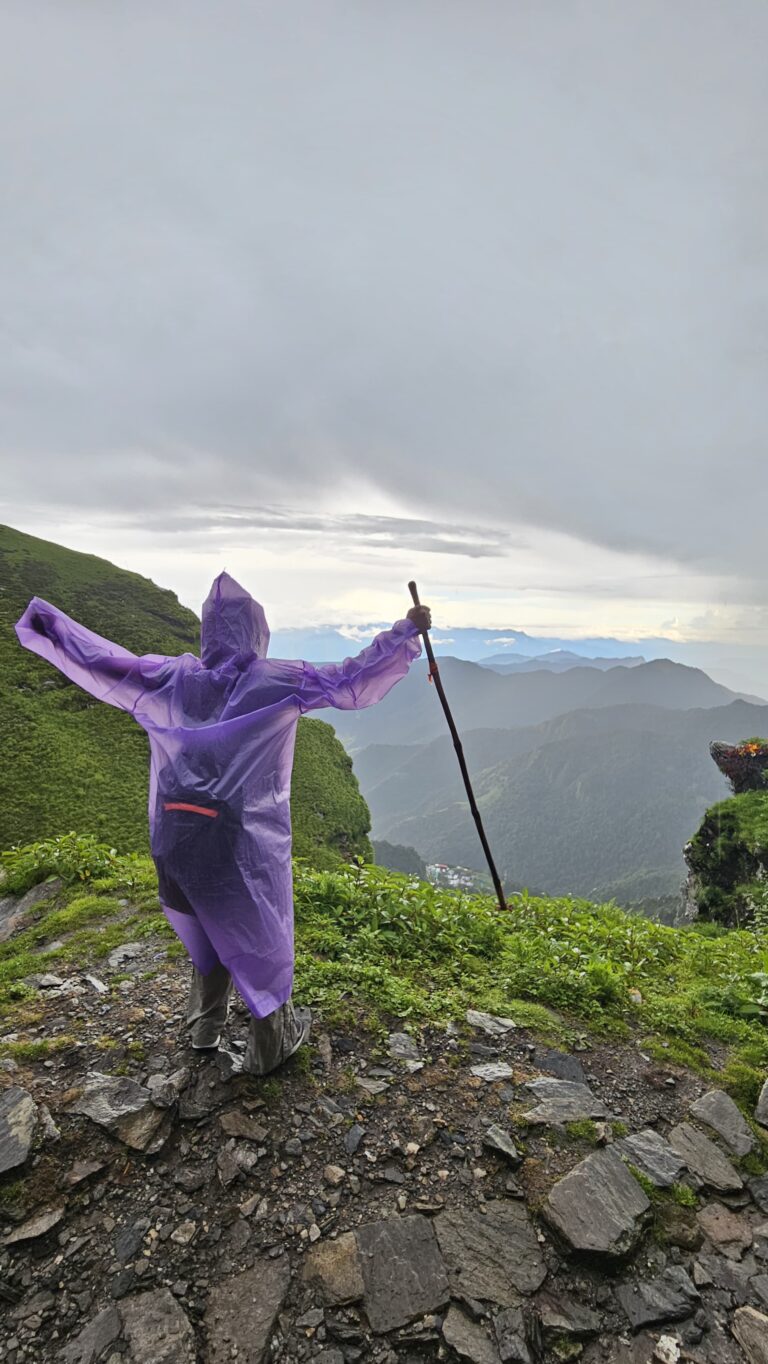
Month-by-Month Weather Guide for Chopta Trekkers & Travelers
Understanding Chopta's weather month-by-month is essential for planning the perfect Chopta tour package to match your desired experience. Each period offers distinct conditions that will greatly impact your trek and overall enjoyment of this incredibly beautiful region.
-
January - February: These are the absolute coldest months, often with heavy snowfall. Temperatures can drop well below freezing (e.g., -5°C to -15°C). This period is ideal for snow lovers and experienced winter trekkers. Roads to the higher parts might be blocked, potentially requiring alternative arrangements for your Chopta Tungnath trek from Delhi.
-
March - April: Spring begins with the melting of snow, bringing pleasant temperatures (around 5°C to 20°C). This is when rhododendrons bloom in vibrant colors, making the landscape particularly beautiful. These months are great for the Chopta Tungnath trek and the Chandrashila summit trek as trails become clearer and more accessible.
-
May - June: This is the peak summer season, offering mild temperatures (10°C to 25°C) and consistently clear skies. This period is the most popular time for the Chopta Chandrashila trek because all routes are open, and conditions are wonderfully ideal for hiking. The Tungnath temple trek is fully accessible during these months.
-
July - August: This is the monsoon season, bringing moderate to heavy rainfall. Temperatures typically range from 10°C to 20°C. The landscapes are exceptionally lush green and often misty. Trails can be slippery, and occasional landslides are possible. It's best for truly adventurous souls seeking solitude and unique misty views.
-
September - October: After the monsoon, the skies are generally clear, and the air is crisp and clean. Temperatures are very pleasant (5°C to 20°C). The greenery is still vibrant, but the trails are dry and firm. This is another excellent time for trekking and enjoying clear, panoramic mountain views, including the Chandrashila trek from Delhi.
-
November - December: Early winter begins to set in, with temperatures gradually dropping (0°C to 15°C). The landscape takes on beautiful golden hues as autumn transitions to winter. Snowfall might start in late December, especially at higher altitudes, which usually leads to the closure of the Tungnath Temple. This period offers superb clear views before the heavy snow arrives.
When planning your Chopta tour package, always consider these monthly weather patterns. For a comfortable Chopta Tungnath trek, spring and autumn are strongly recommended. For those wanting a true snow experience, be ready for colder conditions and potential challenges. Always check the very latest local weather forecast before you embark on your Tungnath Chandrashila trek from Delhi.
Best Trekking Season for Tungnath and Chandrashila
Deciding the best time to undertake the Tungnath and Chandrashila trek largely depends on your personal preference for weather conditions and the level of trekking challenge you desire. This famous Chopta Tungnath trek is accessible for a significant portion of the year, with each season offering its own unique and distinct experience.
For the majority of trekkers seeking comfort and ease, the months of May, June, September, and October are generally considered to be the most ideal.
-
May-June (Summer):
-
Perfect Weather: Pleasant temperatures, typically ranging from 10°C to 25°C, make the Chopta Tungnath trek very comfortable and enjoyable.
-
Clear Trails: The paths are generally dry and completely free of snow, which makes the ascent to the Tungnath temple trek and then onward to the Chandrashila summit trek much easier and safer.
-
Lush Greenery: The meadows are vibrant and in full bloom, providing wonderfully picturesque scenery all along the route.
-
Temple Open: The Tungnath Temple is fully open for darshan, allowing pilgrims easy access. This is the peak season for a Chopta tour package focused on comfortable and rewarding trekking.
-
-
September-October (Post-Monsoon/Autumn):
-
Crystal Clear Views: The skies are typically free of monsoon clouds, offering truly breathtaking panoramic views from the Chandrashila summit trek.
-
Crisp, Clean Air: The air is fresh and invigorating, perfect for long, enjoyable walks amidst the mountains.
-
Dry Trails: Trails are usually dry and firm, ideal for steady and confident progress.
-
Golden Hues: The landscape begins to take on beautiful autumnal colors as the lush green starts to transition, adding a different aesthetic to your journey. This period is a top pick for a scenic Chopta Chandrashila trek from Delhi.
-
For those who crave a challenging snow adventure, January to early March provides a thrilling Chopta Chandrashila trek. The entire route is covered in deep snow, transforming it into a proper winter expedition. However, it's important to note that the Tungnath Temple typically remains closed during this period due to heavy snow, so darshan is not possible. A Chandrashila trek from Delhi in winter demands specific gear and the expertise of a local guide.
Monsoon season (July-August) can be quite challenging due to slippery trails and the possibility of landslides, making the Tungnath Chandrashila trek from Delhi less recommended for casual trekkers. Nevertheless, it does offer a unique misty beauty for the truly adventurous and well-prepared. Overall, for comfort, accessibility, and clear, expansive views, spring and autumn stand out as the best trekking seasons.
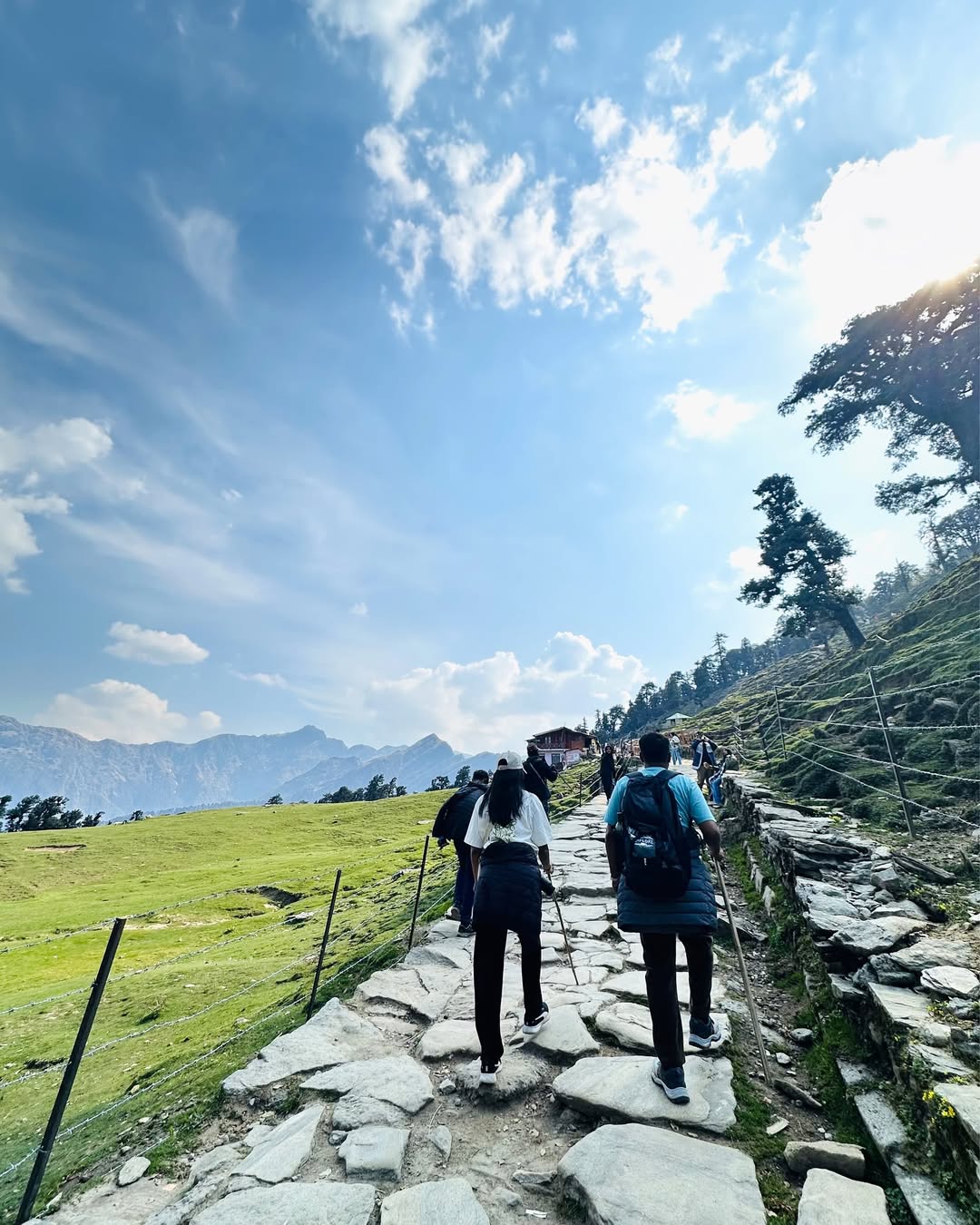
Photography Lover’s Guide – When Chopta Looks the Most Stunning
Chopta is a true paradise for photographers, and its stunning natural beauty transforms dramatically with each passing season. Knowing when to visit can make all the difference for your Chopta tour package and the specific kind of photographs you aim to capture. Each period offers distinct lighting, colors, and textures.
-
Winter (January to March): The White Wonderland
-
Subjects: Focus on expansive snow-covered landscapes, frost-laden trees, and dramatic, often monochromatic scenes.
-
Light: You'll find soft, diffused light on snowy days, creating subtle tones. On clear winter days, the light is sharp and bright, perfect for capturing deep shadows and brilliant whites.
-
Highlights: The Chopta Tungnath trek route completely blanketed in snow, the Tungnath temple trek standing majestically against its pristine white surroundings, and the Chandrashila summit trek offering vast, snow-covered Himalayan panoramas.
-
Tips: Remember to carry extra camera batteries, as cold temperatures drain them faster. Always use waterproof camera bags and have plenty of lens wipes for snow or condensation.
-
-
Spring (March to April): Colors Unleashed
-
Subjects: Vibrant rhododendron blossoms in shades of red and pink, fresh green meadows, and melting snow patches revealing new life.
-
Light: Generally bright and cheerful, ideal for truly capturing the intense and vivid colors of the blooming flowers.
-
Highlights: The Chopta Chandrashila trek lined with blossoming trees, colorful foregrounds against clear mountain backdrops.
-
Tips: Experiment with macro shots of the individual flowers. A polarizing filter can greatly enhance the colors and reduce any unwanted glare.
-
-
Summer (May to June): Clear & Lush
-
Subjects: Deep green valleys, crystal-clear blue skies, and distinct, distant snow-capped peaks.
-
Light: Characterized by strong, clear light. This is best for wide-angle landscape shots and capturing the magical golden hour light during sunrise and sunset.
-
Highlights: Enjoy breathtaking panoramic views from the Chandrashila summit trek. Capture amazing clear sightlines of the Himalayas from any point on the Chopta Tungnath trek from Delhi.
-
Tips: Use a wide-angle lens for sweeping landscapes. Be sure to capture the sunrise from Chandrashila for truly spectacular light and views.
-
-
Monsoon (July to September): Misty & Mysterious
-
Subjects: Low-hanging clouds and mist, dense, wet forests, powerful gushing waterfalls, and incredibly vibrant, wet foliage.
-
Light: Soft, diffused light on overcast days; dramatic contrasts when the sun briefly breaks through the clouds.
-
Highlights: Capture the Tungnath Chandrashila trek from Delhi shrouded in fog for ethereal, moody shots. Focus on macro photography of raindrops on leaves, and the sheer power of swelling waterfalls.
-
Tips: Ensure all your camera gear is fully waterproof. Carry plenty of lens cloths, and truly embrace the unique, atmospheric mood the monsoon provides.
-
For a comprehensive photography-focused Chopta tour package, autumn (September to November) also provides fantastic opportunities. It offers crisp air and beautiful golden hues, combined with excellent visibility for distant peaks, presenting a wonderful blend of clear skies and rich, subtle colors.
Temple Trails – Best Time to Visit Tungnath for Darshan & Peace
Visiting Tungnath Temple is a deeply spiritual highlight for many, and choosing the right time for your Chopta Tungnath trek can significantly enhance your experience. As the highest Shiva temple in the world, its accessibility relies heavily on the seasonal weather conditions.
The temple typically opens its sacred doors for pilgrims around late April or early May each year, after the snow has largely melted. It generally remains open until late October or early November, when the onset of heavy snowfall forces its closure for the winter months.
-
Best Time for Darshan (Pilgrimage): May to June
-
Accessibility: The walking trails are completely clear of snow, making the Tungnath temple trek comfortable and easy to navigate for pilgrims of all ages and fitness levels.
-
Weather: Pleasant daytime temperatures are ideal for the trek itself and for spending time in peaceful contemplation at the temple complex.
-
Temple Services: All temple rituals, ceremonies, and services are fully operational during these months.
-
Popularity: This is the peak season, meaning while conditions are perfect, you can expect more fellow devotees on the trail. A Chopta tour package during these months is very popular for pilgrims.
-
-
Best Time for Peace & Solitude: September to October
-
Fewer Crowds: After the summer rush and the monsoon rains, the number of visitors decreases significantly, offering a much quieter and more serene temple experience.
-
Clear Views: Post-monsoon, the skies are generally clear and crisp, providing excellent visibility of the stunning surrounding peaks from the temple grounds.
-
Invigorating Air: The air is fresh and invigorating, perfect for peaceful contemplation and enjoying the spiritual atmosphere.
-
Temple Still Open: The temple remains open during these months, allowing for peaceful darshan without the bustling crowds of peak season. This period is ideal for a tranquil Chopta Chandrashila trek.
-
Visiting the temple during the winter months (December to March) is generally not possible for darshan, as the idol is moved to Mukumath, and the temple structure itself becomes buried under heavy snow. While adventurous trekkers might attempt the Chopta Tungnath trek from Delhi for the thrilling snowy challenge, the primary focus wouldn't be on traditional temple rituals. Therefore, for a complete spiritual experience combined with pleasant weather and a sense of peace, planning your Tungnath Chandrashila trek from Delhi during late spring or early autumn is highly recommended.
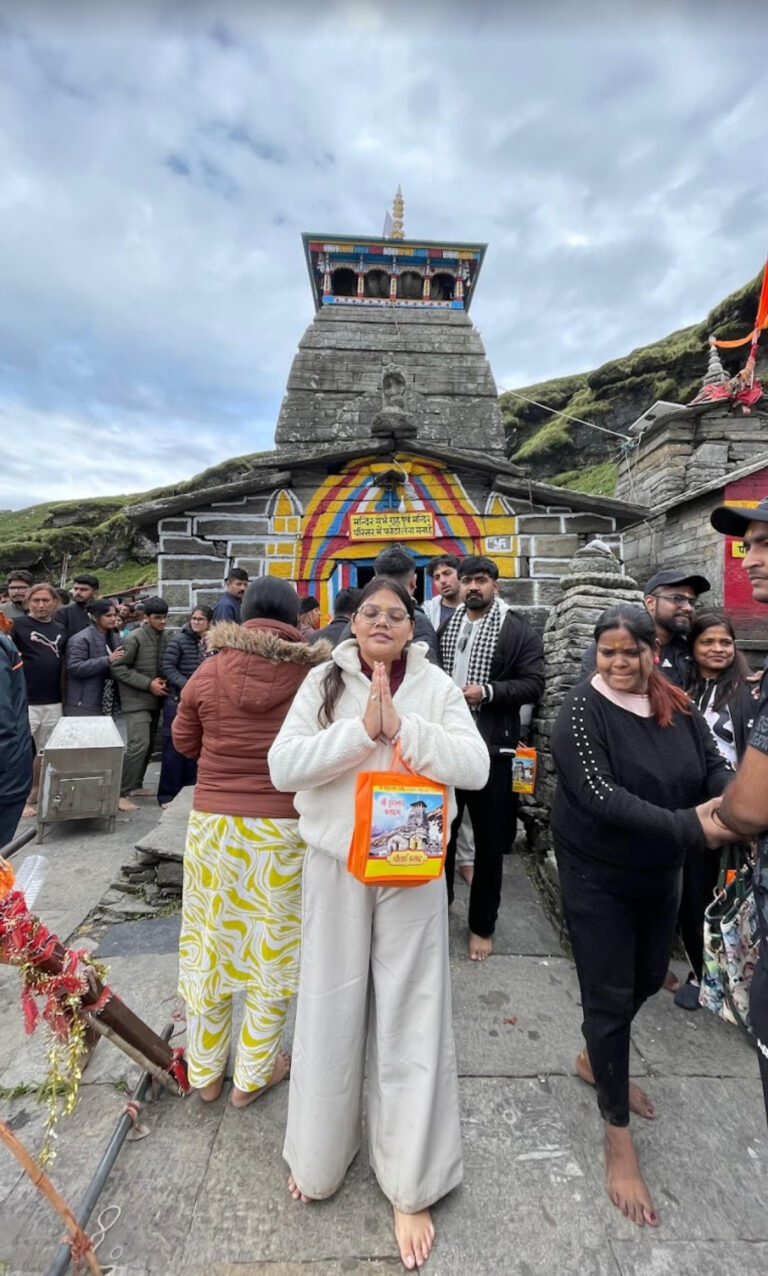
Camping in Chopta – Season-wise Tips for Tent Life in the Wild
Camping in Chopta offers an incredible opportunity to truly connect with nature and experience the wilderness up close. Your camping experience, however, can vary greatly with the changing seasons. If your Chopta tour package includes tent life, careful planning based on the time of year is essential.
-
Summer Camping (May to June): Most Popular & Comfortable
-
Weather: Mild days and pleasantly cool nights create comfortable sleeping conditions. There's less chance of extreme cold temperatures.
-
Trails: All trekking paths, including for the Chopta Tungnath trek, are clear and easily accessible.
-
Tips:
-
Carry a good quality, breathable sleeping bag suitable for temperatures around 0°C to 5°C.
-
Pack multiple layers of clothing, as evenings can still get quite chilly even in summer.
-
Insect repellent is a good idea to protect against mosquitoes and other bugs.
-
It's wise to book your Chopta camping spots in advance, as this is peak season.
-
-
-
Monsoon Camping (July to August): Adventurous & Wet
-
Weather: Cooler temperatures prevail, but expect frequent and sometimes heavy rain. The ground can become very wet and muddy.
-
Challenges: There's a risk of slippery ground, and in some areas, leeches might be present. Road blockages due to landslides are also a possibility.
-
Tips:
-
Essential: A high-quality, fully waterproof tent with a strong rainfly and a durable ground tarp is crucial.
-
Bring waterproof dry bags for all your personal belongings and electronic devices.
-
Waterproof trekking shoes with excellent grip are an absolute must for any Chopta Chandrashila trek during this time.
-
Choose established campsites for better safety and support. A specialized Chopta tour package tailored for monsoon might offer better logistical assistance.
-
-
-
Autumn Camping (September to October): Crisp & Clear
-
Weather: Characterized by clear skies, crisp, invigorating air, and pleasant daytime temperatures. Nights, however, can get quite cold.
-
Benefits: This season offers excellent visibility for stargazing and wonderfully clear views from the Chandrashila summit trek.
-
Tips:
-
Bring warmer sleeping bags, rated for comfort in temperatures around -5°C to 0°C.
-
Layered clothing is crucial to manage fluctuating temperatures throughout the day and night.
-
Enjoy bonfires under the beautifully clear, star-studded sky.
-
This is a fantastic time for a peaceful Chopta Tungnath trek from Delhi combined with serene and comfortable camping.
-
-
-
Winter Camping (December to March): For the Hardcore Adventurer
-
Weather: Extremely cold conditions, with heavy snowfall. Temperatures can drop significantly below freezing.
-
Challenges: Requires specialized winter camping gear, including highly insulated tents, and very warm sleeping bags (rated for -15°C to -10°C or colder).
-
Tips:
-
Winter-rated gear is non-negotiable for both warmth and safety.
-
Consider booking a guided Chopta Chandrashila trek from Delhi with experienced winter camping providers.
-
Be fully prepared for deep snow, potential isolation, and challenging conditions.
-
-
Regardless of the season, always choose a reliable Chopta tour package provider that prioritizes safety and supplies well-maintained camping equipment for your adventure.
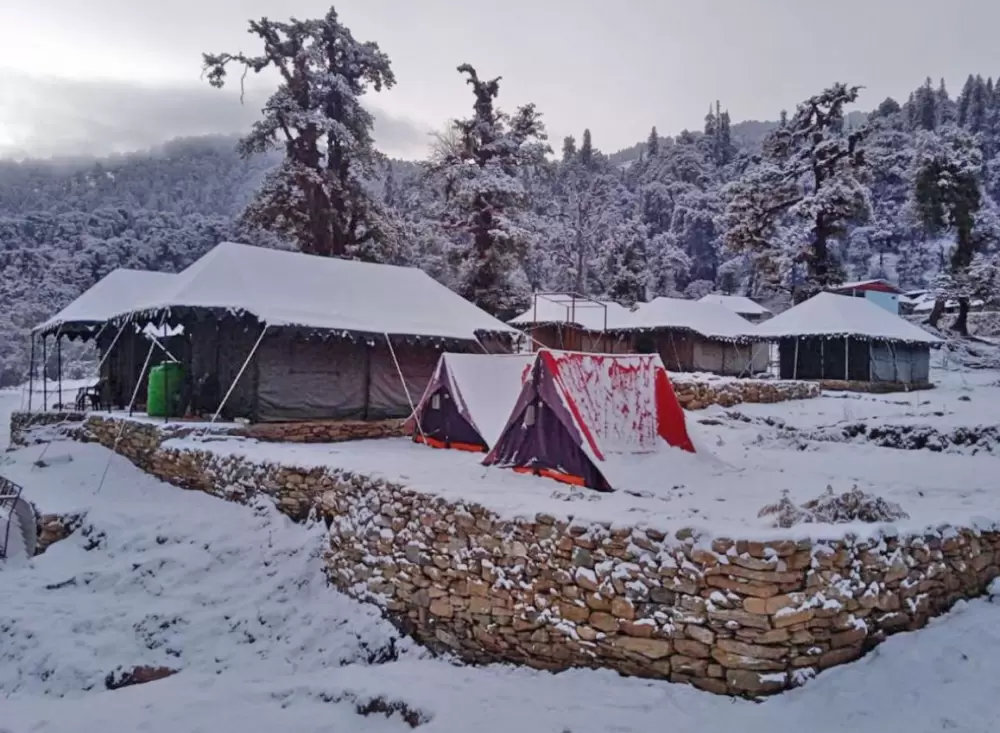
Birdwatching & Wildlife – What You Can Spot Each Season
Chopta is a true haven for birdwatchers and wildlife enthusiasts, being a vital part of the Kedarnath Wildlife Sanctuary. The diverse natural environment here supports over 220 species of birds, and the opportunities to spot unique Himalayan wildlife change with each season. This seasonal variation can significantly influence your ideal Chopta tour package if wildlife viewing is a priority.
-
Winter (December to March): Pheasants & Winter Migrants
-
Birds: This is the absolute best time to spot various elusive pheasants, including the stunning Himalayan Monal (which is Uttarakhand's state bird), the Koklass Pheasant, and the Cheer Pheasant. The Eurasian Woodcock, a distinct winter visitor, can also often be seen.
-
Wildlife: Your chances of spotting larger animals like the Himalayan Tahr and Musk Deer increase during winter, as they tend to descend to lower altitudes in search of food. Their tracks are also clearly visible in the fresh snow.
-
Tips: Dress warmly in layers, move quietly to avoid disturbing wildlife, and carry good quality binoculars for clear sightings. A dedicated Chopta Tungnath trek from Delhi in winter can sometimes be arranged specifically for birdwatching excursions.
-
-
Spring (March to April): Migratory Birds & Active Wildlife
-
Birds: Many migratory bird species begin to return to the region, and resident birds become much more active and vocal, especially during their breeding season. Look out for various warblers, finches, and thrushes.
-
Wildlife: Animals generally become more active after the harsh winter months. The lush new greenery provides ample food sources, making them easier to spot.
-
Tips: Early mornings are consistently the best time for birdwatching. The vibrant blooming rhododendrons during this period create a beautiful backdrop for bird photography. A Chopta Chandrashila trek in spring offers excellent opportunities for sightings along the trail.
-
-
Summer (May to June): High Altitude Species & Breeding Season
-
Birds: High-altitude bird species are more visible during summer, and many are in their striking breeding plumage. You might spot sunbirds and various types of flycatchers.
-
Wildlife: Animals are more dispersed across the higher alpine meadows. Spotting them might require a bit more patience and keen observation.
-
Tips: Combine your birdwatching with your primary Chopta Tungnath trek. The pleasant weather allows for longer observation periods without discomfort.
-
-
Monsoon (July to September): Lush Habitat & Elusive Sightings
-
Birds: While the landscape is incredibly lush, the dense foliage and frequent rain can make birdwatching challenging. However, some specific species thrive in the wet environment.
-
Wildlife: Animals might be more elusive due to the thick vegetation and constant rain.
-
Tips: Focus more on identifying bird calls rather than visual sightings. Be prepared for wet conditions if you opt for a Chopta tour package during monsoon.
-
For serious birdwatchers, the period from March to November (avoiding the heaviest monsoon rains) is generally recommended as many species are present. Consider booking a specialized Chopta tour package that focuses on birding, which might include visits to specific hotspots like Deoriatal, Pothibasa, and Kanchula Kharak, all known for their rich avian diversity. The peace and quiet of a Chandrashila trek from Delhi can often lead to unexpected and delightful wildlife encounters.
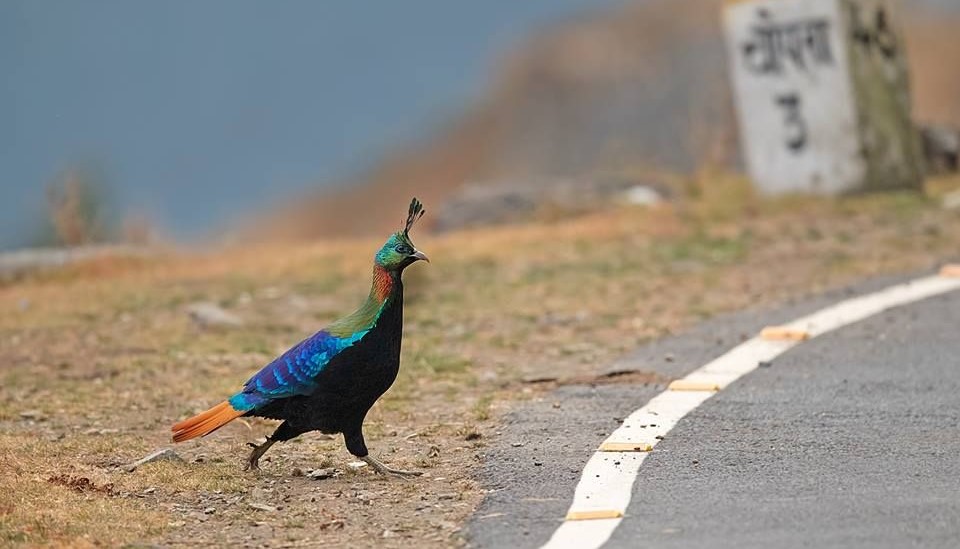
Chopta Tour Package Recommendations for Every Month
Choosing the right Chopta tour package is largely about what you seek, as the experience changes dramatically from month to month. This guide will help you pick the perfect adventure based on the time of year.
-
January - February:
-
Recommendation: Snow Trekking Adventure. This focuses entirely on the stunning snow-covered landscapes, offering challenging walks that require proper gear. Expect cozy campfires in the evenings. Be ready for heavy snow and potential road closures.
-
Ideal for: Adventurers, winter photographers, and those seeking extreme solitude.
-
-
March - April:
-
Recommendation: Spring Bloom & Gentle Trekking. This trip is perfect for enjoying the vibrant blooming rhododendrons, combined with pleasant weather and easily accessible trails.
-
Ideal for: Nature lovers, beginner trekkers, and photographers seeking colorful landscapes.
-
-
May - June:
-
Recommendation: Classic Trekking & Scenic Views. This is the most popular time for a Chopta tour package because of clear views, lush green surroundings, and very comfortable trekking conditions to both Tungnath and Chandrashila.
-
Ideal for: Families, first-time trekkers, and anyone wanting a classic Himalayan experience.
-
-
July - August:
-
Recommendation: Monsoon Mystique & Solitude. This is for adventurous souls who don't mind rain. The focus is on misty landscapes, beautiful gushing waterfalls, and enjoying the tranquility of fewer crowds. Waterproof gear is essential.
-
Ideal for: Solitude seekers, hardcore trekkers, and unique landscape photographers.
-
-
September - October:
-
Recommendation: Autumn Colors & Clear Skies. This offers post-monsoon freshness, crisp air, and stunningly clear views of the mountain peaks, with the meadows taking on beautiful golden hues. Excellent for photography.
-
Ideal for: Landscape photographers, trekkers seeking clear views, and those preferring moderate weather.
-
-
November - December:
-
Recommendation: Early Winter & Golden Landscapes. This is a transition period, offering clear views before heavy snow sets in. You might even experience early snowfall in December, creating a magical atmosphere.
-
Ideal for: Those seeking quiet trails, crisp air, and a glimpse of winter before it fully descends.
-
No matter which month you choose, a well-organized Chopta tour package from a reliable provider will handle all the logistics, provide expert guides, and arrange comfortable accommodation, ensuring a smooth and enjoyable journey. Always check the very latest local weather conditions before your departure for any Tungnath Chandrashila trek from Delhi.
Packing Guide for Chopta – Based on Season & Trek Level
Packing smartly is absolutely essential for any Chopta tour package, as the weather in the Himalayas can change quickly and without warning. Your specific gear will vary significantly depending on the season you choose for your trip and the difficulty level of your planned Chopta Tungnath trek.
-
For Summer (May - June) & Autumn (Sept - Oct): Comfortable Trekking
-
Clothing: Layered clothing is crucial. Pack light t-shirts, comfortable trekking pants, warm fleece jackets, and a light windbreaker or a waterproof raincoat. Evenings can still get cool, so one extra warm layer is advised.
-
Footwear: Sturdy, well-broken-in trekking shoes with excellent ankle support and good grip are a must. Bring several extra pairs of socks, preferably made of wool or synthetic material to keep your feet dry.
-
Essentials: High-SPF sunscreen (SPF 30+ or higher), sunglasses to protect your eyes from glare, a wide-brimmed hat, a refillable water bottle or hydration pack, a basic first-aid kit with blister treatment, any personal medications, a headlamp or torch with extra batteries, and a power bank for your devices. Don't forget basic toiletries.
-
-
For Winter (Dec - March): Snow Trekking & Extreme Cold
-
Clothing: This requires heavy-duty clothing. Pack thermal innerwear (both top and bottom), multiple layers of thick fleece, a warm down jacket or a very heavy woolen jacket. A waterproof and windproof outer shell is vital. Don't forget a warm woolen cap, insulated gloves, and a neck gaiter to protect exposed skin.
-
Footwear: You will need waterproof, insulated trekking boots, preferably high-ankle ones for snow protection. Several pairs of thick woolen socks are essential. Snow gaiters are also highly recommended to prevent snow from entering your boots. Crampons might be needed for icy patches, which are often provided by Chopta Tungnath trek from Delhi operators.
-
Essentials: Very high-SPF sunscreen, moisturizing lip balm, skin moisturizer to combat dryness, a headlamp with plenty of extra batteries, a thermos flask to carry hot water or tea, hand warmers, a comprehensive first-aid kit, and plenty of high-energy snacks.
-
-
For Monsoon (July - Aug): Wet & Misty Adventures
-
Clothing: Prioritize quick-drying synthetic clothes. A high-quality waterproof and breathable rain jacket along with rain pants or a sturdy poncho are indispensable. Pack several extra changes of clothes, as things can get wet quickly.
-
Footwear: Waterproof trekking shoes with excellent grip are absolutely essential for navigating muddy and slippery trails. Consider wearing anti-leech socks if you'll be trekking through dense, wet forest areas.
-
Essentials: A reliable waterproof backpack cover, multiple dry bags for protecting electronics and other valuables, insect repellent, a small quick-drying towel, and a basic first-aid kit that includes anti-fungal cream.
-
Regardless of the season you choose for your Chandrashila trek from Delhi, always carry a valid government ID. Try to keep your backpack as light as possible, but ensure all crucial items for your safety and comfort are included.

Which Season Suits You Best – Adventure, Photography or Solitude?
Chopta offers a distinctly different feel in each season, making it perfectly suited for a variety of interests and preferences. When considering and booking your Chopta tour package, it's helpful to first think about what kind of experience you truly desire to have in the mountains.
-
For Adventure Seekers: Winter (December - March)
-
Why: This is the ultimate season for snow trekking and real challenge. Both the Chopta Tungnath trek and the Chandrashila summit trek transform into demanding, snow-covered routes, testing your physical and mental endurance. The unique thrill of walking through deep, untouched snow and reaching a frozen mountain top is truly unparalleled and exhilarating.
-
Experience: This adventure requires appropriate winter gear, good physical fitness, and it is highly recommended to undertake a guided Chopta Chandrashila trek from Delhi for safety reasons. It's a raw, exciting, and unforgettable adventure.
-
-
For Photography Lovers: Spring (March - April) & Autumn (September - October)
-
Why:
-
Spring: Offers an explosion of vibrant rhododendron colors and fresh, lush greenery, providing incredibly lively and colorful scenes for your camera.
-
Autumn: Characterized by crisp, clear skies that provide unparalleled, sweeping views of snow-capped peaks. The subtle golden hues of the autumn foliage are exceptionally photogenic.
-
-
Experience: Both these seasons offer excellent visibility and a diverse range of natural beauty. Spring is ideal for close-up (macro) shots of flowers, while autumn provides breathtaking opportunities for grand, wide-angle landscape photography.
-
-
For Solitude Seekers: Monsoon (July - August) & Early Winter (November - Mid-December)
-
Why:
-
Monsoon: The rainfall keeps most tourists away, resulting in incredibly peaceful and quiet trails. The misty, dreamy atmosphere only adds to the sense of solitude.
-
Early Winter: Before the onset of heavy snowfall, November and early December offer clear skies and tranquil trails, as the peak tourist season has already passed.
-
-
Experience: You'll largely have the majestic mountains to yourself, which allows for deep introspection and a profound, personal connection with nature. Be prepared for the specific weather challenges that each of these seasons might present.
-
Ultimately, whether you are planning a challenging Chopta Tungnath trek from Delhi for an adrenaline-fueled adventure, a serene Chandrashila trek from Delhi to capture stunning photographs, or a quiet escape to find solitude, Chopta has a perfect time of year tailored specifically to your needs and desires.
When to Travel for a Crowd-Free Chopta Experience
For travelers who deeply value peace and quiet, avoiding large crowds is absolutely essential to truly enjoy Chopta’s unique natural beauty. While this charming Himalayan region is generally less crowded compared to more well-known hill stations, certain times of the year offer even more solitude. Planning your Chopta tour package during these specific off-peak seasons is the most effective way to ensure a tranquil experience.
-
Monsoon Season (July to August): The Absolute Quietest Time
-
Why: The consistent rainfall during these months naturally deters the majority of tourists, leaving the trekking trails and vast meadows largely deserted. You'll get to experience a deeply quiet and wonderfully introspective journey.
-
Conditions: Be prepared for trails that can be slippery and muddy. Occasional landslides are a possibility, which might cause temporary road blockages. Proper rain gear and a high degree of caution are essential for safety.
-
Experience: This period offers a unique misty, lush green landscape with powerful, gushing waterfalls. It's perfect for a tranquil Chopta Tungnath trek if you are fully prepared for wet conditions and a more rugged adventure.
-
-
Early Winter (November to Mid-December): Before the Snow Rush
-
Why: The busy autumn trekking season has passed, and the period of heavy snowfall (which attracts a different set of snow trekkers) hasn't fully begun. This window offers clear, crisp weather with fewer people.
-
Conditions: Daytime temperatures are cool and pleasant, but nights become quite cold. There’s a chance of early snowfall, especially at higher altitudes.
-
Experience: Enjoy crystal-clear skies for panoramic views from the Chandrashila summit, with the landscape gradually turning golden as autumn transitions into winter, often with hints of white. It's a wonderfully peaceful Chopta Chandrashila trek before the major winter crowds arrive.
-
-
Mid-Week Travel (Any Season): Always Less Crowded
-
Why: Regardless of the time of year, making your travel plans for weekdays (typically Tuesday, Wednesday, or Thursday) will consistently result in a less crowded experience compared to weekend visits.
-
Experience: You'll likely find better availability for accommodations, enjoy quieter trails for your Chopta Tungnath trek from Delhi, and experience a much more relaxed and unhurried pace throughout your trip.
-
Tips: If your schedule permits, always choose weekday departures when planning your Chopta tour package to maximize your chances of a crowd-free experience.
-
While these periods offer significantly more solitude, they do come with their own specific weather challenges. Always make sure to check current conditions and be adequately prepared for them. If a completely crowd-free experience is your top priority, these off-peak times are undoubtedly your best bet for a truly serene and undisturbed Himalayan escape.
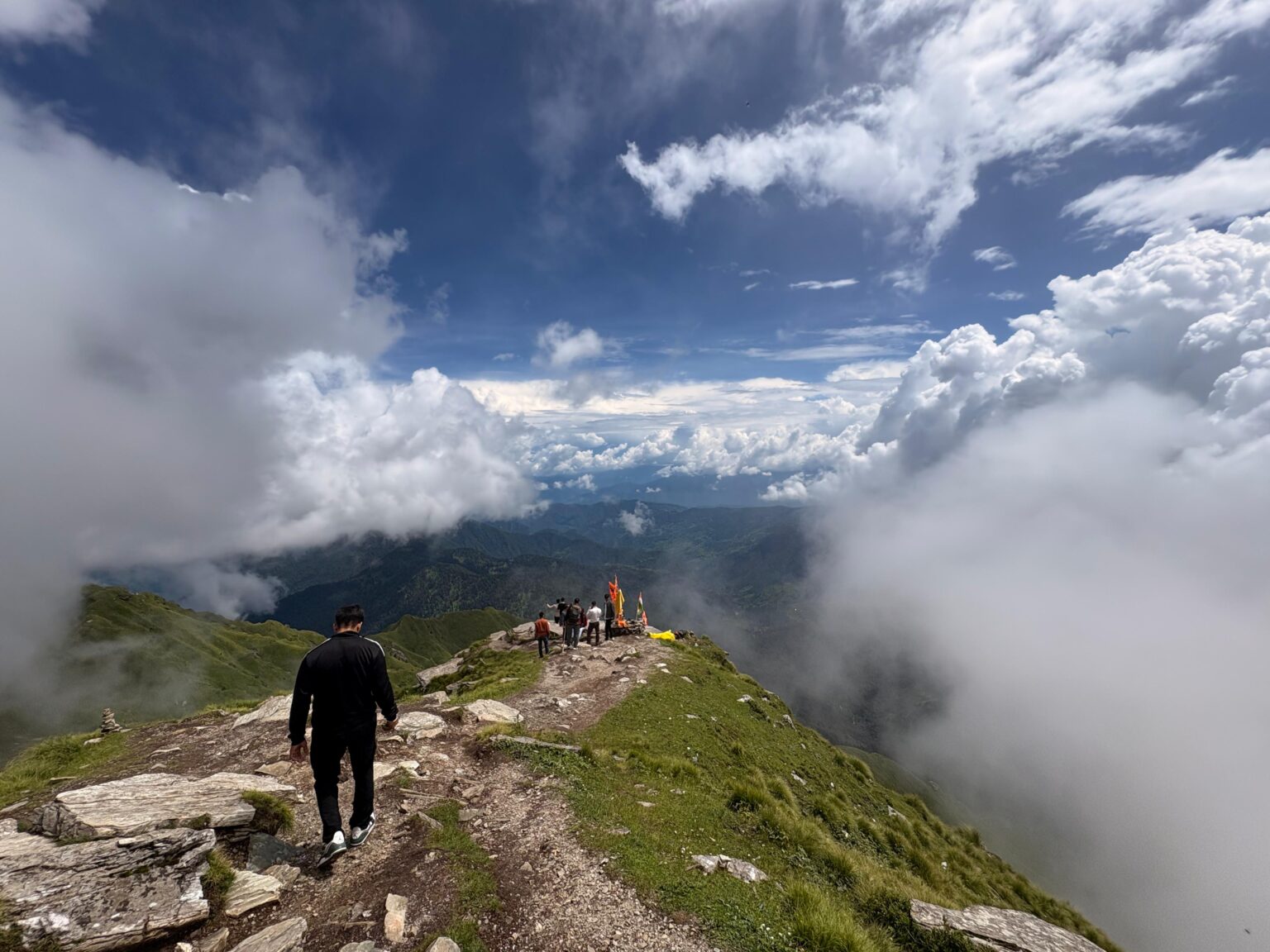
Plan Your Chopta Tour Package with the Right Season in Mind
Choosing the perfect Chopta tour package is perhaps the most important decision you'll make, and it truly begins with selecting the right season. Your entire experience in this incredibly beautiful Himalayan destination will be deeply shaped by the prevailing weather conditions, the accessibility of the trekking trails, and the specific kind of natural beauty that is on display. By carefully aligning your personal preferences with the unique seasonal offerings of Chopta, you can ensure that your trip fully meets and even exceeds all your expectations.
-
For Snow Lovers: If your ultimate dream is to trek through a winter wonderland and experience crisp, cold conditions, then aim for a visit between January and early March. Be thoroughly prepared for challenging conditions on the Chopta Tungnath trek and the Chandrashila summit trek, as snow can be very deep.
-
For Bloom Enthusiasts: To witness the magnificent rhododendron flowers painting the hillsides in vibrant hues of red and pink, plan your Chopta tour package for March to April. This is a visually stunning time, ideal for a more gentle and picturesque Chopta Chandrashila trek.
-
For Comfortable Trekking & Clear Views: The months of May, June, September, and October are ideal. These periods offer consistently pleasant weather, clear skies, and fully accessible and well-maintained trails for both the sacred Tungnath temple trek and the exhilarating Chandrashila trek from Delhi.
-
For Adventurous & Solitary Souls: If you don't mind embracing the rain and are seeking profound quietness, then July to August (the monsoon season) offers a truly unique, misty, and wonderfully crowd-free experience on your Tungnath Chandrashila trek from Delhi.
When considering your trip, think about these key priorities:
-
Physical Challenge: Winter offers the most demanding and adventurous treks.
-
Scenic Beauty: Spring is perfect for blooming flowers, autumn provides stunning clear vistas and golden colors, and winter transforms the landscape into a snowy paradise.
-
Peace & Quiet: The monsoon season and the period of early winter are generally the best times for finding true solitude on the trails.
-
Temple Visit: The Tungnath temple is officially open for pilgrims and visitors from May to October.
Discuss these preferences in detail when you reach out to plan your Chopta tour package. A good and experienced tour operator will be able to help you choose an itinerary that perfectly matches your desired seasonal experience, ensuring that your Tungnath Chandrashila trek from Delhi is everything you hoped for and creates lasting memories.

FAQs – Everything to Know About Chandrashila Trek from Chopta
1. What is included in a typical Chopta tour package?
Most Chopta tour packages include transportation, accommodation, meals, guided treks to Tungnath Temple and Chandrashila, and basic camping gear if required.
2. How difficult is the Chopta Tungnath trek?
It’s a moderate trek suitable for beginners with basic fitness. The trail is well-marked and scenic.
3. What is the best time to visit Chopta and Tungnath?
March to June and September to November are ideal. Snow lovers prefer December to February.
4. Is the Chandrashila trek suitable for beginners?
Yes, the Chopta Chandrashila trek is beginner-friendly and often chosen by first-time trekkers and families.
5. How long is the Chopta Tungnath trek?
The trek from Chopta to Tungnath is around 3.5 km one way, and an additional 1.5 km to Chandrashila summit.
6. What’s the altitude of Tungnath and Chandrashila?
Tungnath Temple sits at 3,680 meters, while Chandrashila summit is at 4,000 meters above sea level.
7. Are there Chopta tour packages from Delhi or Haridwar?
Yes, you can book a Chopta tour package from Delhi, Haridwar, Rishikesh, and Dehradun with flexible pricing options.
8. What is the average Chopta tour package price?
The price typically ranges from ₹5,500 to ₹9,000 per person, depending on the duration, group size, and inclusions.
9. Is Tungnath temple open throughout the year?
No, Tungnath Temple remains open from April/May to October/November and closes during winter due to heavy snowfall.
10. What kind of wildlife can I see in Chopta?
Chopta is rich in biodiversity—expect to see monals, musk deer, langurs, and a variety of Himalayan birds and flora.
